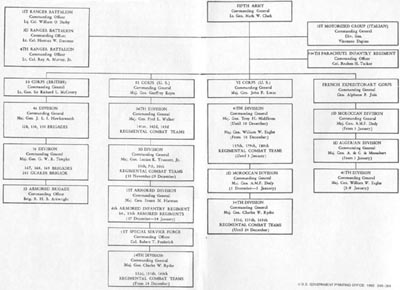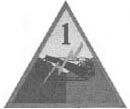Conclusion
THE WINTER LINE campaign ended in mid-January with Allied gains on both
sides of the Apennines. To the east, the British Eighth Army had crossed
the Sangro and Moro rivers and made a thirteen-mile advance, principally
in the area near the Adriatic coast. On a thirty-five mile front, Fifth
Army had forced the enemy back into his Gustav Line and reached the edge
of the Liri Valley, main corridor for advance to Rome from the southeast.
In both zones, a stubborn and skillful enemy had limited the Allied success,
and his defense had never disintegrated; neither Fifth nor Eighth Army
had been given an opportunity to make the hoped-for breakthrough, either
by opening up the Liri Valley or by a northeast flanking maneuver past
Ortona toward Rome.
Nevertheless, in view of difficulties faced, Fifth Army's accomplishment
was notable. Measured in miles of advance the gain may not seem great for
two months of fighting. But this progress had been made against an enemy
who was defending with his main forces the strongest system of fortifications
yet encountered in Italy. The enemy had been defeated on ground of his
own choosing, whatever difficulties this ground presented. He would have
plenty of opportunity, in the rugged mountains of central Italy, to stand
and fight on other organized defensive systems, but the Allies had shown
their determination to assault such lines, and their ability to carry them
under the most adverse conditions of weather and terrain.
Winter, ideal defensive ground, and the enemy's hard fighting made the
Winter Line operations not only slow but costly. Combat units paid heavily
for local successes, which they could not exploit fully because reserves
were never sufficient to force a breakthrough.
113
Fifth Army battle losses from 15 November to 15 January were 15,930
men. Over half this numberó8,844ócame from American divisions and represented
a casualty rate of ten percent. Non-battle casualties were much higher,
numbering nearly fifty thousand for all the American elements of Fifth
Army.
Enemy strength had been even more severely taxed, the two thousand prisoners
taken in this campaign by Fifth Army representing only a small part of
German losses. Their local reserves had been used to the point where the
Germans could not mount a counteroffensive; moreover, their defense of
Rome and central Italy became
increasingly difficult, however strong the defensive lines. The value of the
Allied effort and the damage done to German military strength became clearer
in the course of 1944. In the larger background of the European theater, every
victory by the Allies in Italy, every increase in pressure on the Germans holding
the Italian front, made it less and less possible for Hitler's high command
to draw from Kesselring's twenty-two divisions for reinforcement of other fronts
against the mounting Allied threat. The enemy having decided to fight it out
in Italy, Allied armies were waging offensive warfare calculated to make him
pay a maximum price for his decision.
114-115
ORGANIZATION OF FIFTH ARMY
(15 November 1943 - 15 January 1944)

116-117
page created 20 July 2001
Return to the Table of
Contents
Return to CMH
Online












